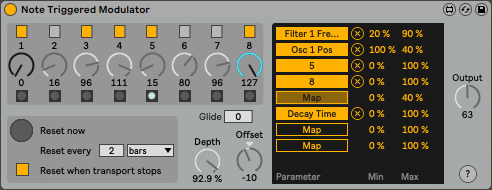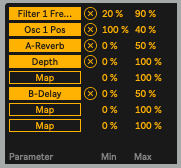
Note Triggered Modulator is free and available from maxforlive.com
Introduction
Note Triggered Modulator is a variable-length parameter sequencer, driven by note input rather than a clock. It outputs a sequence of modulation values, which can be mapped to up to eight parameters in Live, each with independent ranges and scaling.
Each of the sequencer’s eight steps can be toggled on or off. Disabled steps are skipped.
This device is inspired by two earlier Max for Live devices: Note Trigger Step Sequencer 1.0 by Prebentious and Note Trigger Parameter Step Sequencer 2.0 by dfodel
Video tutorial
An 18 minute video walkthrough is available below:
Controls
Step controls

Adjust a knob to set the corresponding step to a value between 0 and 127. A button above each knob toggles that step on or off. Skipped steps are ignored, meaning the sequence can be between zero and eight steps long. The indicator lights below the knobs show the progress of the sequence.
Glide – sets how long it takes (in milliseconds) for each step’s value to change to the next step’s value. With Glide set to 0, the values change immediately.
Depth – adjusts the intensity of the modulation. At 100%, the full value of a step is output. At 50%, the output is half the step’s value.
Offset – shifts the output values by up to plus or minus 64. Values below 0 or above 127 are clipped.
Mapping controls

To map a parameter, click one of the Map buttons and then click a parameter in Live. Adjust the Min and Max sliders to scale the range for the assigned parameter. Note that Max can be lower than Min, which results in inverted scaling. To unmap a parameter, click the X to the right of the corresponding Map button.
Reset options

Reset now – immediately resets the sequence to the first enabled step.
This button can be MIDI or Key mapped, and also automated. But there are a number of specific things to watch out for – see the Known issues section below for more information.
Reset every x – these controls cause the sequence to reset at specific rhythmic positions when Live’s transport is running.
When “bars” is selected, the resets will be based on Live’s global time signature.
Note that the reset positions are absolute (determined by Live’s Arrangement Position) rather than relative (determined by the duration of playback). For example, if “Reset every 2 bars” is selected, the sequence will reset at bar 3, 5, 7, 9, etc. Thus if playback begins at bar 2, a reset will occur one bar later.
When 0 is selected in the number slider, the Reset every x functionality is disabled.
Reset now – immediately begins playing back from the first stored pitch.
This button can be MIDI or Key mapped, and also automated. But there are a number of specific things to watch out for – see the Known issues section below for more information.
Known issues
- If a MIDI note or computer keyboard key is mapped to Reset Now, every other press of the key or note will be ignored. Mapping this button works best with a footswitch.
- Live’s automation can’t represent triggering a momentary button. In order to automate Reset Now, it’s necessary to automate turning it on AND turning it off.
- When automating Reset Now, it’s necessary to place the automation slightly before the time when you would like it to occur.
- At extremely fast tempos or when changing meters, the Reset every x functionality may not work reliably.